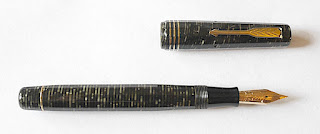The Hopi Cultural Center
Now for something different. From Zion Canyon we took a
fairly long drive, about 300 miles, backtracking into Arizona to visit the Hopi
Cultural Center at Second Mesa in the heart of the Hopi Nation. On the way we
stopped briefly at Glen Canyon Dam, before powering on, so to speak, to the
Hopi Nation which curiously, is surrounded by the lands of the Navajos. Gotta
find out how that happened.
As Sharon observed at lunch, shortly after entering this
land we felt like we should have passports. This is a different culture and one
that has very carefully chosen what elements of mainstream culture to accept
and what not, and often the decision has been made village by village. One of
the things made clear in several of the villages is that, while we were welcome
to visit, there are rules including prohibitions on photographing and sketching.
I hope tomorrow to find out why, whether it is some sort of cultural, religious
thing or a deasire not to be misrepresented. While I totally respect that
limitation, I found myself looking at buildings hungrily, wanting desperately
to photograph them, not because they were picturesque (they aren’t) but because
they represent a culture so very foreign to us.
So, one of the things we decided to do is something I don’t
think we have ever done in our travels, not even in China (which is as exotic
as we have gotten) and that is to hire a guide for tomorrow. But, not content
to simply laze about this afternoon, we decided to ramble on our own and ended
up visiting a rather interesting village. Old Orayvi Village on the second mesa
dates itself back to 900AD, though others mark it as more recently settled, in
~1100 AD. The village is purely traditional, and that means that the governing
council has decreed no power lines, no running water, because to do so would
disrupt the air and the ground of their ancestors. What led us there was the
gallery of Sandra Hamada, which is reknowned for exquisite arts we spent a bit
of money on a traditionally carved and wrought Katsina as well as some other
small objects. When we return home I’ll do some images of our katsina, but for
now the delicate figure is wrapped up. Sandy also educated us in the history
and culture of the village, then and now.
As we emerged we were invited by one of the men of the
village to visit his mother’s pottery and to see some figures that he and a
friend had carved and painted. I am ashamed to say that I do not remember his
name, even though I bought a signed piece of his work. I’m too lazy now to go
out to the car to retrieve it. But the main event, as it were, was a fifteen
minute lecture on traditional pottery making. Only later did we find out that
she is a retired teacher (figures), and so she taught and demonstrated how
traditional pottery is made in the ways that she learned from her grandmother.
To the outside eye, this village would look primitive,
ramshackle and impoverished. It would seem to reinforce all the stereotypes of
native Americans as victims, but without anyone saying it the message is clear,
these are people, many of whom are educated, who have chosen to limit many of
the modern conveniences in order to preserve their heritage. I don’t want to
minimize the plight of Native Americans in mainstream society, or to overly
romanticize, but their lives in many ways represent a balancing act that I
centainly did not understand until this afternoon.
We spent the rest of the afternoon driving through a bit of
the rest of the Hopi nation, and as we headed back, I cheated and used about
1200 mm of real and digital telephoto to capture images of a village from a
distance. These are the villages of the first mesa, as opposed to the traditionalist
second mesa and they look more like the images of “impoverished” Native America
we are used to seeing.










Comments